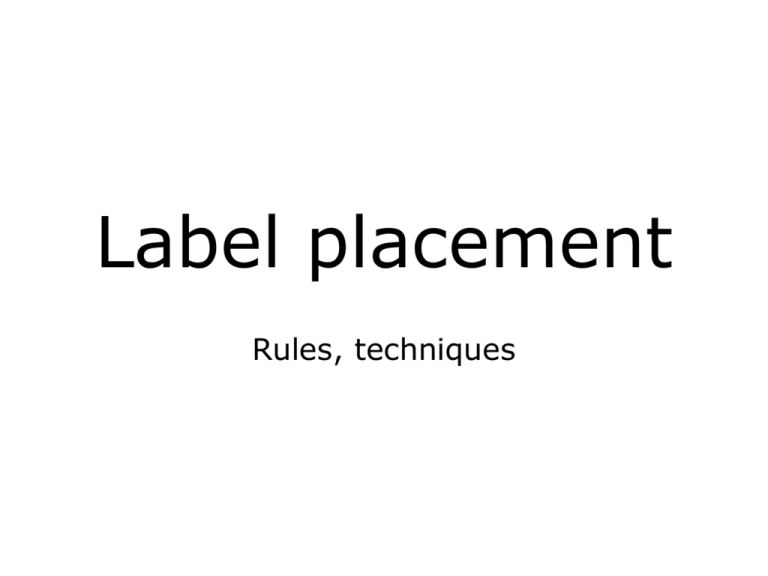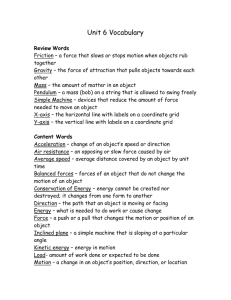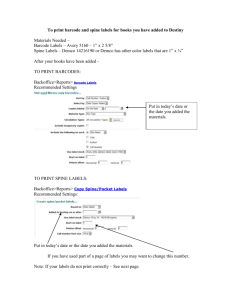Label placement
advertisement

Label placement Rules, techniques Labels on a map • Text, name of map features • No fixed geographical position • Labels of point features (0-dim), line features (1-dim), areal features (2-dim) Labels of point features • Cities on a small-scale map • Heights of peaks • Measured values at measurement points Labels of point features Touristic sights, campgrounds Labels of line features • Rivers • Heights on contour lines • Streets Labels of areal features • Countries, oceans, forests, lakes Three kinds of labels Utrecht Nieuwegein Houten Culemborg Straight, horizontal name Curved name Curved name with spacing between characters Label placement • Where should the text be placed? Which shape? • 20% - 50% of the map production time; can be automated • Which rules do cartographers use? - No overlap readability - Clear for which feature association - Aesthetical guidelines Rules according to Imhof (1962) Problematic cases Problem association Thunder Bay and point Problem visibility highway 20 Problem readability name Another problematic case University Ave. is interrupted 4 times Specific rules point labels • Label must be close to point, preferably to the right and above • No overlap with other labels, except perhaps in the spacing of the areal label • Label may intersect line feature; then line must be interrupted • Points close to large body of water must have their label in the water. In other cases there may be no line between a point and its label • If it cannot be avoided, a name may be split over two lines of text Specific rules line labels • Label must follow shape of river • Label should not bend upwards and downwards consecutively • At long line features the label must be repeated • No extra spacing between characters, spacing between words of the label is allowed • For vertical line features: upward reading direction left on the map and downward right on the map • Contour lines: labels must interrupt contour line; top label points to higher regions Specific rules areal labels • Horizontal labeling is good unless this conflicts with the dominant shape of the region • Monotonous curving; no inflection points • Label must be spread over whole region • Non-horizontal labels must be curved • Adjacent regions preferably have same shape of label (both horizontal, e.g.) • Sometimes an areal label may be outside its region, but not in another labeled region Strategies for automatic label placement • Compute for each feature various candidate positions according to the rules • Choose for each feature one candidate position, such that the chosen positions don’t have overlap • Sometimes a feature cannot be labeled, and sometimes the label of a feature must be repeated Candidate positions points • Point labels 8-position model 4-position model slider model More general model more labels can be placed, but more complex/ expensive to compute Candidate positions lines • Compute strip with character height above the river which follows the shape approximately, but doesn’t have too high curvature (e.g. with opening, closure) • Determine suitable segments in the strip as candidates Candidate positions regions • Determine skeleton (medial axis) of region (polygon) • Determine longest path on skeleton as dominant shape • Choose middle with suitable character spacing • Vary a little for more candidates Candidate positions regions, horizontal • Choose spacing and determine length : height of label • Compute largest scaled copy of the label (rectangle) that just fits inside the polygon • Put the label in the correct font size in the middle of the scaled copy B e l g i ë B e l g i ë B e l g i ë Removal part of the candidates • Compute those candidate positions that intersect map features significantly, or would give unclear association, and remove them Nieuwegein Nieuwegein Nieuwegein Reasons for removal Utrecht Utrecht Zeist Utrecht Utrecht Readability text Utrecht Zeist Visibility features Utrecht Association Choosing from the candidates • Translate to a graph problem (graph G): - each candidate position of each feature is a node in G - two nodes have an edge in G if their candidate positions intersect - two nodes have an edge in G if their candidate positions are of the same feature Example Utrecht Utrecht Bunnik Bunnik Utrecht Utrecht Bunnik Bunnik Computing intersecting candidates • Each candidate is (approximately) a simple geometric shape • Determine all pairs of intersecting candidates using a plane sweep algorithm • O((n+k) log n) time, with k the number of intersecting pairs • Typically: k = O(n) Graph problem: maximum independent set • Also called maximum stable set • NP-hard problem: solving optimally is very time consuming • Cannot be approximated with performance guarantees • Many heuristics Heuristics for maximum independent set • Select each candidate that is adjacent to a clique, and remove the candidate and clique from the graph • Repeat as long as possible (optimal selections) • Select candidate that intersects few other candidates • Select candidate if a feature has only one (or a few) candidates left • Eliminate candidates that intersect many candidates Refinements • Features and labels have different importances translate problem to maximum weight independent set • First place areal labels, then determine candidate point labels and select, then determine line labels and place them (order of decreasing freedom of placement) Labels in GIS • Can label positions be pre-computed and stored, for better efficiency? No, because – Which themes are shown is not known beforehand; – Which scale and size of the map is needed is not known beforehand Labels on interactive maps • Pop-up labels, or labels only after click • During zooming in, remove labels when their feature goes outside the frame • During zooming in, allow more and more labels; during zooming out, remove labels of less important features Size of labels does not change! Commercial packages • Maplex for ESRI’s ArcInfo and ArcGIS • EverName for MapInfo • MapText for ArcInfo, ArcGIS, MapInfo, GeoMedia, … User Interface of EverName Output of EverName Output of MapText





